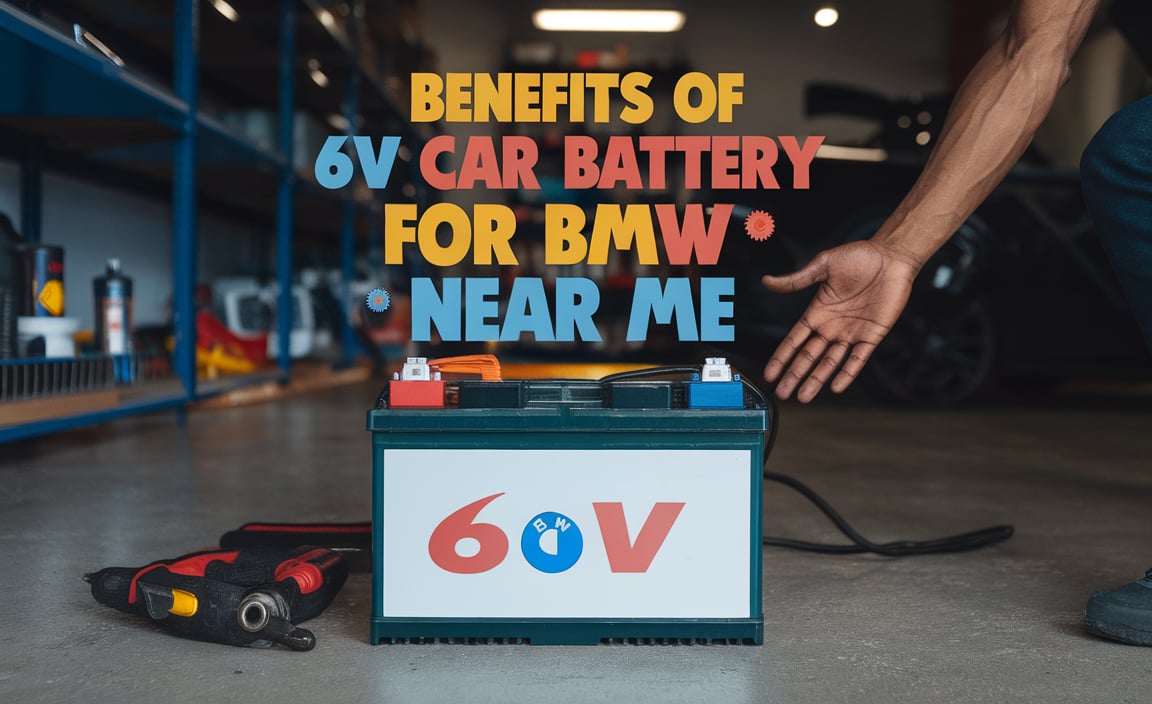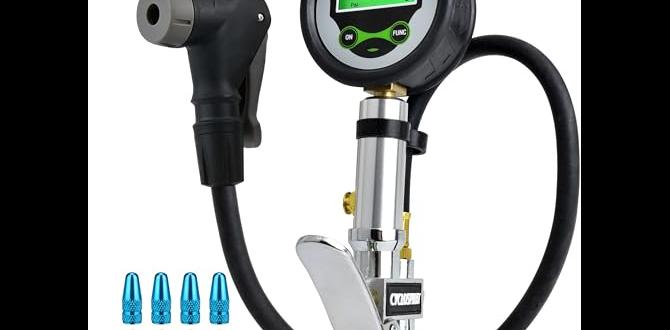Quick Summary: Looking for a cheap gel car battery for trucks? Gel batteries offer vibration resistance and deep discharge capability, ideal for demanding truck use. While often pricier upfront than traditional lead-acid, finding budget-friendly options is possible with smart shopping, ensuring reliable power without breaking the bank.
Is your truck’s battery giving you trouble? Maybe it struggles to start on cold mornings, or perhaps you’re planning some serious off-roading and need a battery that can handle a bit more. Choosing the right battery can feel like a big decision, especially when you’re trying to keep costs down. Truck batteries have a tough job, powering everything from the engine to extra lights and sound systems. A good, reliable battery is crucial for safe driving and peace of mind.
You’ve probably heard of different types of car batteries, like the standard flooded versions and the newer gel types. Gel batteries, in particular, have some neat features that make them a great fit for trucks. They are known for being more resilient and can even be mounted in different positions. But what does “gel” actually mean, and how can you find a quality one that won’t cost a fortune? Stick around, and we’ll break down everything you need to know about finding a cheap gel car battery for your truck so you can get back on the road with confidence.
Why Gel Batteries Are a Smart Choice for Trucks
When we talk about picking a battery for a truck, we’re not just talking about starting the engine. Trucks often have more electrical demands than regular cars. Think about campers, winches, powerful stereo systems, or even extra lighting for work or adventure. This is where a gel battery can really shine.
What Exactly is a Gel Battery?
Unlike traditional car batteries that have liquid electrolyte, a gel car battery uses a special electrolyte that’s like a jelly or gel. This “gelled” sulphuric acid is trapped within a silica-based matrix. This design is what gives gel batteries their unique advantages:
- No Spills: Because the electrolyte is gelled, it won’t spill even if the battery is tipped on its side. This is a huge plus for trucks, which can experience a lot of jostling on rough terrain.
- Vibration Resistance: The gel structure is more robust and less prone to damage from constant vibrations that truck suspensions deal with. This means they tend to last longer in trucks than standard batteries.
- Deep Discharge Capability: Gel batteries can often handle being discharged more deeply than flooded batteries without suffering as much damage. This is great if you run accessories with the engine off for extended periods.
- Lower Self-Discharge: They lose their charge more slowly when not in use, making them reliable even if your truck sits for a while.
The “Cheap” Factor: Setting Realistic Expectations
When you hear “cheap gel car battery for trucks,” it’s important to manage expectations. Gel batteries typically have a higher upfront cost than standard flooded batteries. This is due to the more complex manufacturing process and materials involved. However, “cheap” in this context often means finding the best value and a reliable option at a competitive price point, rather than simply the absolute lowest price available.
The long-term savings can come from their longer lifespan, especially in demanding truck environments, and their lower maintenance needs. A cheaper battery that fails prematurely will end up costing you more in the long run. So, we’re aiming for affordable reliability.
Key Features to Look for in a Gel Truck Battery
When you’re on the hunt for a cheap gel car battery for trucks, certain specifications will tell you if you’re getting a good deal for your needs. Don’t just grab the first one you see; a little knowledge goes a long way.
Cold Cranking Amps (CCA)
This is super important. CCA measures how much power the battery can deliver in freezing temperatures to start the engine. Trucks, especially those used in colder climates or with larger diesel engines, need a high CCA rating. Check your truck’s manual or the label on your old battery for the recommended CCA. Aim for a gel battery that meets or slightly exceeds this minimum.
Reserve Capacity (RC)
Reserve Capacity tells you how long a fully charged battery can deliver 25 amps at 80°F (27°C) before its voltage drops below 10.5 volts. For trucks with lots of accessories or if you do a lot of idling, a higher RC is beneficial. It means your battery can power your truck’s systems for longer without the engine running.
Battery Size and Terminal Type
This one is straightforward but critical: the battery must fit physically in your truck’s battery tray and have the correct terminal configuration. Truck batteries use standardized groups, like Group 31, Group 65, or Group 24F. Make sure the one you choose matches your truck’s requirements. Incorrect size means it won’t fit, and wrong terminal types can prevent proper connection.
Brand Reputation and Warranty
Even when looking for a “cheap” option, brand matters. Established battery manufacturers often have better quality control. Look for brands known for reliable batteries. A good warranty (e.g., 1-3 years) can also be a lifesaver. It shows the manufacturer stands behind their product and can offer protection if you encounter issues.
Tip: Check online reviews specifically for the battery model you’re considering and any mentions of its performance in trucks.
Where to Find Affordable Gel Batteries
Finding a cheap gel car battery for trucks doesn’t mean you have to compromise on quality. Smart shopping is key. Here are some of the best places to look:
1. Automotive Parts Stores (Online and Brick-and-Mortar)
Major auto parts retailers are often your best bet. They carry a wide range of brands and types. Many offer online ordering with options for in-store pickup or home delivery.
- Advantages: Wide selection, competitive pricing, knowledgeable staff, easy returns, and often have sales or loyalty programs worth checking.
- Where to look: AutoZone, Advance Auto Parts, O’Reilly Auto Parts, Pep Boys, and similar chains.
2. Online Retailers
The internet is a treasure trove for finding deals. You can often find batteries at lower prices online than in physical stores, thanks to lower overheads for sellers.
- Advantages: Huge selection, price comparison tools, customer reviews, often the best prices for specific models.
- Where to look: Amazon, eBay, Walmart online, and specialized online battery retailers.
Writer’s Note: When buying online, pay close attention to shipping costs for batteries, as they can be heavy and sometimes expensive to ship. Also, check the return policy carefully.
3. Direct from Manufacturers (Sometimes)
While less common for individuals, some battery manufacturers might offer direct sales or have specific promotions. This is usually more for fleet buyers, but it’s worth checking their websites.
4. Discount and Budget Brands
Some brands focus on offering more budget-friendly options. While you might not get the absolute longest lifespan or highest performance, a good discount gel battery can still be a perfectly adequate and cost-effective solution for many trucks.
5. Used or Refurbished Batteries (Use with Caution)
You might find “used” or “refurbished” gel batteries at a very low price. While tempting, this is generally not recommended for critical truck applications. Batteries degrade with age and use, and a used one might be near the end of its life, leading to an investment that doesn’t pay off. If you consider this route, ensure there’s a solid warranty and understand the risks.
Comparing Gel vs. AGM vs. Standard Flooded Batteries for Trucks
It’s helpful to know how gel batteries stack up against other common types you might encounter when looking for a truck battery. You’ll often see Absorbed Glass Mat (AGM) batteries mentioned alongside gel. Both are types of “sealed” batteries, meaning they don’t require regular watering like flooded batteries.
| Feature | Gel Battery | AGM Battery | Standard Flooded Battery |
|---|---|---|---|
| Electrolyte | Gelled (silica-based) | Absorbed into fiberglass mat | Liquid sulfuric acid |
| Spill Proof | Excellent | Excellent | Poor (can spill if tipped) |
| Vibration Resistance | Very Good | Excellent | Fair |
| Deep Discharge Tolerance | Good | Excellent | Fair (can be damaged by deep discharge) |
| Charging Sensitivity | Sensitive; requires specific charger and settings | Less sensitive than gel, but still requires proper charging | More tolerant to standard charging |
| Cost (Typical) | Mid to High | Mid to High | Low to Mid |
| Ideal Use Case for Trucks | General heavy-duty, moderate accessory use, vibration resistance | Heavy accessory loads, deep cycling, high vibration, extreme temps | Basic starting, budget-conscious, standard use |
Why the distinction matters for trucks:
- AGM batteries are often considered the top tier for heavy-duty truck applications because of their superior vibration resistance and ability to handle high electrical demands and deep cycling, often seen in modern diesel trucks with lots of electronics.
- Gel batteries are still a great option and often more affordable than AGM while offering better performance than flooded batteries, especially if vibration is more of a concern than extreme deep cycling.
- Standard flooded batteries are the most common and cheapest, but they’re less suited for the harsh environments and high demands many trucks face.
For finding a cheap gel car battery for trucks, you’re looking for a sweet spot of performance and price, bridging the gap between basic and premium. If your truck experiences significant vibration or you need better spill protection, a gel battery is a logical step up from flooded, and can be found at more accessible price points than AGM.
How to Safely Install a New Truck Battery
Installing a new battery, even a gel type, is something many DIYers can handle. Safety is the absolute priority here. Always proceed with caution. If you’re unsure at any point, it’s best to consult a professional or a friend with experience.
Tools You’ll Need:
- New gel car battery
- Wrench set or socket set (typically 10mm, 1/2 inch, or 9/16 inch for terminals and hold-down clamp)
- Battery terminal cleaner brush (wire brush works too)
- Gloves (work gloves or acid-resistant gloves)
- Safety glasses or goggles
- Ratchet and extension (might be needed for hold-down clamp)
- Anti-corrosion spray or grease (optional, but recommended)
- A small bag or container for small parts
Step-by-Step Installation Guide:
- Park Safely and Turn Off Everything: Park your truck on a level surface. Ensure the engine is completely off, and all accessories (lights, radio, etc.) are off. Most importantly, remove the keys from the ignition.
- Locate the Battery: Batteries are usually under the hood, but can sometimes be in the trunk or behind a wheel well. Consult your truck’s owner’s manual if you can’t find it.
- Disconnect the Negative Terminal First: This is the most crucial safety step. The negative terminal is usually marked with a “-” symbol and its cable is often black. Use your wrench to loosen the nut on the negative terminal clamp. Once loose, carefully lift the cable off the terminal post. Tuck it away so it can’t accidentally touch the battery post. Why negative first? This prevents accidental short circuits if your wrench touches the truck’s metal frame while working on the positive terminal.
- Disconnect the Positive Terminal: The positive terminal is marked with a “+” symbol and its cable is usually red. Loosen the nut on the clamp and remove the cable from the post. Again, tuck it away.
- Remove the Hold-Down Clamp: Batteries are secured with a clamp at the base or over the top. You’ll need to remove the bolts or nuts holding this clamp in place. Keep these parts safe!
- Remove the Old Battery: Batteries are very heavy. Lift with your legs, not your back. Carefully slide the old battery out of the tray. If it’s at an angle, be mindful of any residual liquid electrolyte, although gel batteries are much less prone to spillage.
- Clean the Battery Tray and Terminals: Use your battery terminal brush to clean any corrosion from the battery tray and the cable clamps. A clean connection is essential for good electrical flow. You can use a baking soda and water paste to neutralize acid residue if any is present. Rinse and dry thoroughly.
- Install the New Battery: Carefully place the new gel battery into the tray. Ensure it sits firmly and is oriented correctly so the terminals align with the cables.
- Secure the Hold-Down Clamp: Reinstall the hold-down clamp and tighten it securely. The battery should not move.
- Connect the Positive Terminal First: Place the red (positive) cable clamp onto the positive battery post. Tighten the nut securely.
- Connect the Negative Terminal: Place the black (negative) cable clamp onto the negative battery post. Tighten the nut securely.
- Apply Anti-Corrosion (Optional): You can apply a thin layer of anti-corrosion spray or grease to the terminals and clamps to help prevent future corrosion.
- Start the Truck: Start your truck to ensure everything is working correctly. Check that all dashboard lights come on as expected and then turn off.
Important Note on Charging: Gel batteries require specific charging voltages and profiles to avoid damage. Using a standard “lead-acid” charger that’s not designed for AGM or Gel can reduce battery life or even cause failure. Many modern smart chargers have specific settings for gel batteries. Always check the battery manufacturer’s recommendations for charging.
The U.S. Department of Energy provides further tips on battery maintenance that can help extend the life of any car battery.
Maintaining Your Gel Battery for Longevity
Even the best gel battery will benefit from proper care. Since gel batteries are low maintenance, most of your effort will go into ensuring they are charged correctly and connections are clean. This is especially true when looking for the most value from a budget-friendly option.
Regular Inspections
Even though gel batteries are sealed, it’s a good idea to check periodically:
- Clean Terminals: Look for any signs of corrosion on the battery posts and cable clamps. Clean them as described in the installation section if necessary.
- Secure Connections: Ensure the cables are tightly connected to the battery terminals. Loose connections can cause starting problems and damage the battery and charging system.
- Physical Damage: Check the battery case for any cracks, swelling, or leaks, which could indicate internal damage or overcharging.
Proper Charging is Key
This is crucial for gel batteries. Unlike flooded batteries, they are more sensitive to overcharging or undercharging.
- Use the Right Charger: If you use a trickle charger or a smart charger, ensure it’s specifically designed for gel or AGM batteries. These chargers have different voltage and current outputs to safely charge the gel electrolyte. A standard flooded battery charger can overheat and damage a gel battery. Check out resources on Battery University for in-depth charging information.
- Avoid Deep Discharge When Possible: While gel batteries tolerate deep discharge better than flooded ones, frequent deeply draining them can still shorten their lifespan. Try to recharge the battery after significant accessory use.
- Monitor Charging Voltage: If you have a multimeter, you can check the voltage of your battery at rest and while charging to ensure it’s within the manufacturer’s recommended range.
Environmental Considerations
Extreme temperatures can affect battery performance and lifespan.
- Heat: Excessive heat, often found in engine bays, can accelerate the degradation of battery components. Ensure your battery area has some ventilation.
- Cold: Cold temperatures reduce a battery’s cranking power. While gel batteries perform better in cold than some other types, a fully charged battery will always perform best.




